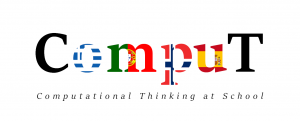Αρχική » 2020
Αρχείο έτους 2020
Dimensions of Computational Thinking in COMPUT project
When we started working on the project Computational Thinking at School, our plan was to study the following dimensions of Computational Thinking creative problem solving algorithmic approach to problem-solving problem solution transfer logical reasoning abstraction generalization representation and organization of data systemic thinking evaluation social impact of computation While working on the dimensions, it proved […]
etwinning / Language portraits
Students were asked to create their language portrait as follows Draw your own language portrait. Include all the languages you know / are familiar with. The languages you speak fluently should take up a larger part of the portrait than the ones where you only know a few words. Write a few sentences about your […]
eTwinning / Avatar Creation
Avatar creation by students eTwinning link More eTwinning activities under tag eTwinning
eTwinning / Teachers
Teachers’ presentation Link at eTwinning More eTwinning activities under tag eTwinning
eTwinning / The image of the other
Students were asked to create digital posters on the images of others Link at eTwinning More eTwinning activities under tag eTwinning




